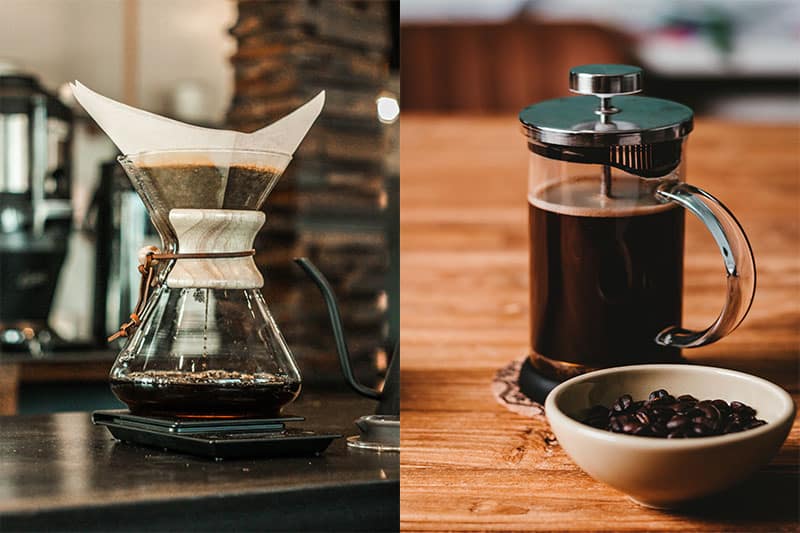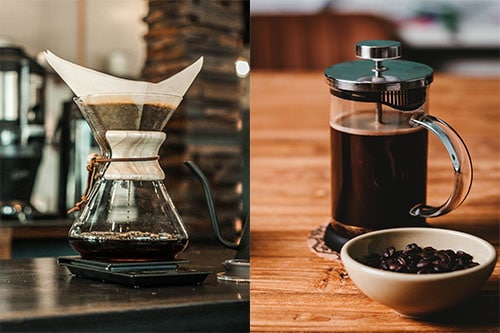
When you want to have a cup of coffee whether its first thing in the morning or for that afternoon pick me up, the way you decide to brew your coffee can be very important. Different brewing methods are used for different results and some are more versatile then others.
Two of the most common and popular coffee brewing methods are the Chemex and the French Press. Different coffee brewing methods are the main thing that set Chemex and French Press brewers apart from each other
What is the difference between and Chemex and a French Press? The main differences are that a Chemex uses a pour over method for brewing coffee and a thick filter where as a French Press is an immersion coffee brewer that does not use a paper filter
Lets find out which coffee brewer will work for your and your needs
Similarities Between Chemex and A French Press
You should first learn how these devices work. The French press is a coffee press. The grounds and hot water are added together in a metal beaker.
A plunger with a screen is then pressed into the beaker, keeping the grounds below the screen and allowing you to pour hot coffee.
The Chemex on the other hand is a manual pour-over-style coffeemaker. The device is normally a glass flask ( but they do come in plastic) with a paper filter. The grounds are added to the filter and you manually pour hot water over the grounds of coffee.
There are manual steps involved when using either device. With a French press, you need to plunge the mesh plunger to separate the fresh coffee from the coffee grounds. With a Chemex, you need to slowly pour hot water on top.
Both options take about three to four minutes to brew since if the coffee brews too quickly, the hot water does not absorb enough of the compounds, resulting in a watered-down coffee. If it takes too long, the coffee may gain a bitter taste. Check out my home brewing post for more info.
What Is the Chemex?
The Chemex was invented in the early 1940s by a chemist. He combined an Erlenmeyer flask with a glass funnel to create his own coffeemaker.
The final product is a glass flask with an hourglass shape. A wood collar is added to the neck of the flask, providing a spot to hold the device and pour coffee without touching the hot glass.
A conical coffee filter is placed in the funnel-shaped top of the device. The filter is similar to the standard filters used in drip coffee makers but thicker. This may offer a few potential benefits, such as removing coffee oils and producing a cleaner brew.
After inserting the filter, the grounds are added. Heated water is then slowly poured over the top of the grounds. The fresh coffee then drips through the filter into the lower flask.
When you are done brewing, you remove the filter and pour the coffee into your cup.
It is essentially just a flask with a wooden collar. However, the simple, elegant design produces clean and fresh coffee.
While the concept is simple, there are various techniques for brewing with the Chemex. For example, some users gently swirl the flask as the coffee brews to help ensure that the water is evenly distributed over the grounds.
What Is the French Press ?
The French press was invented in the early 20th century and patented by Italian designers in 1929. In some regions, it is also called a press pot, a coffee plunger, or a press pot.
The design is based on a method of preparing coffee that was used in France. This method required the use of a pot containing hot water and coffee grounds. A cheesecloth screen was attached to a rod and pressed into the pot. The screen presses the coffee grounds down, allowing the brewer to pour fresh coffee.
The modern design follows this same method. A typical French press is made of stainless steel and resembles a pitcher. The screen is made of metal and sits in the pitcher below the lid. The rod sticks through the lid and may include a handle on top.
Similar to the Chemex coffeemaker, the French press uses a simple concept. However, over the years, various techniques have been developed to get better use out of the French press, such as not pressing the screen down far enough to compress the grounds.
Pros and Cons of Using a Chemex
The Chemex coffeemaker is not as widely known as the French press. People who use it for the first time are often surprised by the quality of the coffee that it produces, which is due to the following advantages:
- The paper filter collects oils.
- The filter removes acids.
- You can easily discard the grounds.
When brewing with the Chemex, you need to use a filter. While the filter is an integral part of the brewing process, it also helps remove oils and acids.
Removing the oils helps to remove some of the bitterness of the coffee. You can brew smooth, fresh coffee in minutes with a Chemex coffeemaker.
The filter also removes acids from the coffee. These acids are known to cause digestive issues for some individuals, especially when consumed on an empty stomach.
The lack of oils and acids makes for a cleaner brew. You can enjoy the health benefits of drinking coffee without some of the potential health risks associated with the oils and acids.
A Chemex also uses heavy filters. These filters tend to be thicker compared to the paper filters commonly used in drip coffee makers, helping to remove more of the acids, oils, and sediment found in the coffee grounds.
When you are done brewing, you can easily clean out the spent grounds. They are already in a disposable filter that you can toss out or you can use the grounds for other uses.
However, due to the hourglass shape of the Chemex flask, it is difficult to clean. Depending on the width of the neck of the Chemex, you may not be able to fit your hand inside to clean it out. Luckily, cleaning tools are available to make the cleaning process a little easier.
A Chemex coffeemaker say for example from Amazon tends to cost more compared to the typical French press. While you can find luxury French presses, they are often available at reasonable prices. The paper filters also add to the cost of using a Chemex.
Some people also struggle with pouring a cup of coffee from a Chemex coffeemaker. If you are not careful, it is easy to pour the coffee too quickly.
Pros and Cons of Using a French Press
The French Press also provides a few advantages compared to the Chemex coffeemaker. These benefits include:
- Easier cleaning
- No need to use filters
- Versatility
The French press is easier to clean, due to the shape of the pitcher and the removable parts. The lid and plunger can be removed, allowing you to thoroughly clean the inside of the pitcher and the separate parts.
The pitcher or base is also typically big enough to fit your hand. Due to the shape, you can easily use a sponge or cleaning cloth to clean out the interior.
The design also eliminates the need for paper filters. The lack of filters makes the French press slightly more environmentally friendly compared to the Chemex coffeemaker and is a little more convenient.
Another benefit is the versatility of the French press. Besides coffee, the device can be used to prepare tea. It is also suitable for preparing cold brew coffee and twice-brewed coffee.
While it is a convenient way to make coffee, the French press has a couple of drawbacks. Coffeemakers that use paper filters can filter out some of the coffee oils and acids. The oils add to the bitterness of the coffee and the acids should not be consumed on an empty stomach.
People with sensitive digestive systems may experience upset stomachs or nausea when drinking highly acidic coffee. However, some people enjoy the bitterness of the coffee prepared with a French press.
The other issue is the coffee grounds. When you are done preparing coffee, the coffee grounds are not always easy to clean out. Instead of containing the grounds in a filter, the grounds sit at the bottom of the press.
Which Coffeemaker Should You Use?
The Chemex coffeemaker (current price on Amazon) and French Press are both inventions from the first half of the 20th century that have become popular options for brewing fresh coffee.
Compared to a standard drip coffee brewer, both options require a little extra work. You need to heat your water separately and then add it.
With the extra effort, you get a much better cup of coffee. But which option should you choose?
If cost is a factor, you can find a cheap French Press on Amazon or Bodum. You also do not need to worry about buying filters.
For those who do not like bitter coffee, a Chemex is the preferred option. The heavy filter helps remove oils and acids, which also makes the coffee easier on the stomach.
Overall, the French press tends to be easier to use. You simply add the hot water and coffee grounds and wait about three to four minutes. You then press the plunger and pour your coffee.
A Chemex coffeemaker requires you to slowly pour the water over the filter. Some people also gently swirl the flask to help distribute the water. When the coffee is ready, pouring the coffee can be a challenge.
In the end, both options produce great-tasting coffee. The choice comes down to your personal preferences. A French Press is considered easier to use while a Chemex brews cleaner coffee.

